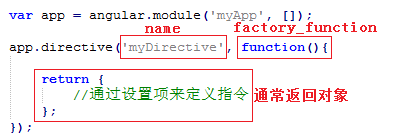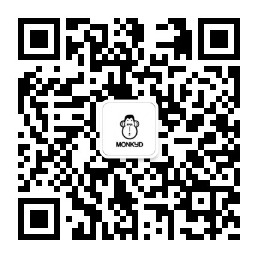AngularJS之指令
2016-08-10 20:52 猴子猿 阅读(1880) 评论(7) 编辑 收藏 举报紧接上篇博客“初探AngularJS”
| 一、前言 |
在AngularJS中指令尤为重要且内容庞多,固单独提炼出来,梳理一番。如有错误,请不吝讲解。
好了,言归正传,让我们一起走进Angular指令的世界。
在上篇博客的前言部分提到,Angular的核心就是对HTML标签的增强。我们用到的诸如ng-app、ng-controller等等这些都是属于Angular指令,具体点,它们为Angular内置的指令。
Angular不仅提供了内置指令,它还允许我们自定义指令,不然Angular就太low咯。
这也是本篇博客的核心:如何自定义指令。
该篇博客原文地址:http://www.cnblogs.com/giggle/p/5746220.html
| 二、自定义指令 |
Angular为我们提供了.directive()这个方法,来定义指令。
如下:

正如上述代码所示,directive方法接受两个参数:name和factory_function。
--name嘛,即为指令的名字,供我们调用时使用;
--factory_function就是当我们调用指令时,指令的实际行为,并且factory_function通常返回一个对象,里面通过规定的设置项来定义指令。
那么自定义指令中,我们都可以操作哪些设置项呢?
如下:

var app = angular.module('myApp', []); app.directive('myDirective', function(){ return { restrict: 'EACM',//告诉AngularJS这个指令在DOM中以何种形式被声明,默认为A priority: Number,//优先级参数(值为数值),数值越大,优先级越高,默认为0 terminal: Boolean,//true或者false,告诉AngularJS是(true)否(false)停止运行当前元素上比本指令优先级低的指令 template: String or Template Function,//模板 templateUrl: String,//模板URL replace: Boolean,//值为true,代表模板会替换掉调用该指令的元素 scope: Boolean or Object,//指令作用域 transclude: Boolean,//true,结合ng-transclude,在该指令中嵌入内容 controller: String or function($scope, $element, $attrs, $transclude, otherInjectables){...},//指令控制器 controllerAs: String,//用来设置控制器的别名 require: String,//将控制器注入到其值所指定的指令中 link: function(scope, element, attrs){...}, compile: function(){} }; });
针对如此众多的设置项,我们一同先挑几个常用且简单的设置项,感受感受吧。
--template & templateUrl--
template模板参数是可选的,其值可以是一段HTML文本,也可以是一个接受两个参数的函数。
注:如果template值为空,或者没有template设置项,那么不会覆盖嵌入在指令内部的元素,且当指令scope为false或者{…}时,内部元素的作用域共享外部父作用域;但,当指令scope为true时,内部元素的作用域就是继承自外部父作用域。
demo如下:

<!DOCTYPE html> <head> <meta charset="utf-8"/> </head> <body ng-app="myModule"> outterDirective:<input type="text" ng-model="name"/><br> <one> innerDirective: <input type="text" ng-model="name"/> </one> <script src="angular.js"></script> <script> var myModule = angular.module('myModule', []); myModule.directive('one', function(){ return { scope: false, restrict: 'E' } }); </script> </body> </html>
效果图如下:


<!DOCTYPE html> <head> <meta charset="utf-8"/> </head> <body ng-app="myModule"> outterDirective:<input type="text" ng-model="name"/><br> <one> innerDirective: <input type="text" ng-model="name"/> </one> <script src="angular.js"></script> <script> var myModule = angular.module('myModule', []); myModule.directive('one', function(){ return { scope: {}, restrict: 'E' } }); </script> </body> </html>
scope:{...}效果同上

<!DOCTYPE html> <head> <meta charset="utf-8"/> </head> <body ng-app="myModule"> outterDirective:<input type="text" ng-model="name"/><br> <one> innerDirective: <input type="text" ng-model="name"/> </one> <script src="angular.js"></script> <script> var myModule = angular.module('myModule', []); myModule.directive('one', function(){ return { scope: true, restrict: 'E' } }); </script> </body> </html>
scope为true,效果图如下:

假设,设置了template后,当我们调用指令后,它会呈现在页面中。下面我们就来具体看看。
1、当template值为一段HTML文本时,demo如下:


<!DOCTYPE html> <head> <meta charset="utf-8"/> </head> <body ng-app="myApp"> <div my-directive></div> <script src="angular.js"></script> <script> var app = angular.module('myApp', []); app.directive('myDirective', function(){ return { template: '<div>\ <h1>Hi everyone!</h1>\ </div>' }; }); </script> </body> </html>
2、当template值为函数时,demo如下:

<!DOCTYPE html> <head> <meta charset="utf-8"/> </head> <body ng-app="myApp"> <div my-directive title="Monkey"></div> <script src="angular.js"></script> <script> var app = angular.module('myApp', []); app.directive('myDirective', function(){ return { /* 值为函数时,接受两个参数tElement, tAttrs: tElement:使用此指令的元素 tAttrs:实例的属性,它是一个由元素上所有的属性组成的集合,即对象 */ template: function(tElement, tAttrs){ var _html = ''; _html +='<div>' + 'Hi,'+tAttrs.title+'</div>'; return _html; } }; }); </script> </body> </html>
利用template可以在指令中自定义我们需要的模板,但是随着模板的体积(代码量)不断变大时,在指令中利用template就显得很糟糕,故而,使用templateUrl引用外部模板,是更好的选择。
--restrict--
restrict 是一个可选参数,它告诉AngularJS这个指令在DOM中以何种形式被调用。一共有四个选择且都为大写,不然没效果,默认为A(属性)。
A(属性):
<div my-directive></div>
E(元素):
<my-directive></my-directive>
C(类名):
<div class="my-directive"></div>
M(注释):
//以注释调用指令时,前后得有空格 <!-- directive:my-directive -->
这四个选项,可以单独使用,亦可混合使用。如:
restrict: ‘EA’就代表可以用元素或者属性调用指令
--replace--
replace是一个可选参数,值为Boolean类型,默认为false,代表模板会被当作子元素插入到调用此指令的元素内部。
如下:

<!DOCTYPE html> <head> <meta charset="utf-8"/> </head> <body ng-app="myApp"> <div my-directive></div> <script src="angular.js"></script> <script> var app = angular.module('myApp', []); app.directive('myDirective', function(){ return { replace: false, template: '<div>Monkey</div>' }; }); </script> </body> </html>
运行后,打开chrome调试器,结果如下:

--replace值为true,即模板会替换掉调用指令的元素,如下:

<!DOCTYPE html> <head> <meta charset="utf-8"/> </head> <body ng-app="myApp"> <div my-directive></div> <script src="angular.js"></script> <script> var app = angular.module('myApp', []); app.directive('myDirective', function(){ return { replace: true, template: '<div>Monkey</div>' }; }); </script> </body> </html>
运行后,打开chrome调试器,结果如下:

且,当值为true时,template会替代调用指令的元素,固template中的值,必须只包含一个根节点,不然会报错,如下:

<!DOCTYPE html> <head> <meta charset="utf-8"/> </head> <body ng-app="myApp"> <div my-directive></div> <script src="angular.js"></script> <script> var app = angular.module('myApp', []); app.directive('myDirective', function(){ return { replace: true, template: '<div>Monkey</div><h1>Dorie</h1>' }; }); </script> </body> </html>
运行后,打开chrome调试器,报错如下:

--transclude--
transclude是一个可选参数,表示是否允许在指令中,嵌入内容。值为Boolean,默认值为false代表不允许在指令中嵌入内容,如果手动设置为true后,要结合ng-transclude指令使用,不然和false效果一样。
下面我们一起来编写两个demo具体看看。

<!DOCTYPE html> <head> <meta charset="utf-8"/> </head> <body ng-app="myApp"> <div my-directive> <span>需要嵌入内容</span> </div> <script src="angular.js"></script> <script> var app = angular.module('myApp', []); app.directive('myDirective', function(){ return { transclude: false, template: '<div>指令内容</div>' }; }); </script> </body> </html>
运行代码,打开chrome调试器得下:

我们再来看看transclude:true的情况,将上述代码中的transclude的值改为true后,运行代码。
咦,我靠和上诉transclude:false的结果一样呢?
哦,对了,虽然我们将transclude的值设为true了,但是要结合ng-transclude指令嘛,不然,你让人家嵌入内容往哪插呢?
利用ng-transclude指令修改代码后,得下:

<!DOCTYPE html> <head> <meta charset="utf-8"/> </head> <body ng-app="myApp"> <div my-directive> <span>需要嵌入内容</span> </div> <script src="angular.js"></script> <script> var app = angular.module('myApp', []); app.directive('myDirective', function(){ return { transclude: true, template: '<div>指令内容</div><div ng-transclude></div>' }; }); </script> </body> </html>
运行代码,打开chrome调试器,得下:

注:利用ng-transclude指令标记的元素中,不管有没有内容,都将等同于无内容情况。
咦,利用transclude嵌入的内容,它们有自己的作用域吗?如果有,那么它们的作用域继承谁呢,指令or外部作用域?
答案:利用ng-transclude嵌入的内容的同时,会创建一个属于自己的作用域,即子作用域,且继承自外部作用域,并非指令。
--scope--
scope参数是可选的,它是直接影响指令的作用域。该参数可以被设置为不同的三个值,分别代表三种不同的作用域,下面我们就来一一说明。
1、scope: false
当scope的值为false时,也就是默认状态,代表指令共享父作用域,即没有自己的作用域。
如下:

<!DOCTYPE html> <head> <meta charset="utf-8"/> </head> <body ng-app="myApp"> Parent:<input type="text" ng-model="name"/> <directive-for-false></directive-for-false> <script src="angular.js"></script> <script> var app = angular.module('myApp', []); app.directive('directiveForFalse', function(){ return { restrict: 'E', scope: false, template: '<div>Child: \ <input type="text" ng-model="name">\ </div>' }; }); </script> </body> </html>
执行上述代码,效果图如下:

2、scope: true
当scope的值为true时,代表指令会创建自己的作用域,且继承自父作用域。
如下:

<!DOCTYPE html> <head> <meta charset="utf-8"/> </head> <body ng-app="myApp"> Parent:<input type="text" ng-model="name"/> <directive-for-true></directive-for-true> <script src="angular.js"></script> <script> var app = angular.module('myApp', []); app.directive('directiveForTrue', function(){ return { restrict: 'E', scope: true, template: '<div>Child: \ <input type="text" ng-model="name">\ </div>' }; }); </script> </body> </html>
执行上述代码,效果图如下:

3、scope: {…}
当scope的值为对象时,代表指令会切断与外界的联系,创建一个隔离的作用域,既不继承于父作用域,也不准内嵌的指令继承于自己。
一起写个demo,感受下“隔离作用域”不继承于父作用域,如下:

<!DOCTYPE html> <head> <meta charset="utf-8"/> </head> <body ng-app="myApp"> Parent:<input type="text" ng-model="name"/> <directive-for-obj></directive-for-obj> <script src="angular.js"></script> <script> var app = angular.module('myApp', []); app.directive('directiveForObj', function(){ return { restrict: 'E', scope: {}, template: '<div>Child: \ <input type="text" ng-model="name">\ </div>' }; }); </script> </body> </html>
执行上述代码,效果图如下:

至于“不准内嵌的指令继承于自己”,参考上面的--transclude--
那当我们将scope设置为对象后,就成了一个无人问津的作用域,这样非常适合我们写插件之类的,但,怎么与外界交互呢?
这就涉及到所谓的绑定策略啦。
如下:
|
scope的绑定策略 |
|
|
@ |
把当前属性作为字符串传递。你还可以绑定来自外层scope的值,在属性值中插入{{ }}即可。 |
|
= |
与父scope中的属性进行双向绑定。 |
|
& |
传递一个来自父scope的函数 |
下面,我们就针对上面的提示,逐个demo,感受体会下。
1、@策略

<!DOCTYPE html> <head> <meta charset="utf-8"/> </head> <body ng-app="myApp"> <input type="text" ng-model="name"/> <directive-for-obj who="{{name}}" love="love Dorie"></directive-for-obj> <script src="angular.js"></script> <script> var app = angular.module('myApp', []); app.directive('directiveForObj', function(){ return { restrict: 'E', scope: { who:'@', what: '@love' }, template: '<div><input type="text" ng-model="who"/> {{what}}</div>' }; }); </script> </body> </html>
效果图,如下:

2、=策略

<!DOCTYPE html> <head> <meta charset="utf-8"/> </head> <body ng-app="myApp"> <input type="text" ng-model="name"/> <directive-for-obj who="name" love="love Dorie"></directive-for-obj> <script src="angular.js"></script> <script> var app = angular.module('myApp', []); app.directive('directiveForObj', function(){ return { restrict: 'E', scope: { who:'=', what: '@love' }, template: '<div><input type="text" ng-model="who"/> {{what}}</div>' }; }); </script> </body> </html>
效果图,如下:

3、&策略


<!DOCTYPE html> <head> <meta charset="utf-8"/> </head> <body ng-app="myApp"> <input type="text" ng-model="name"/> <directive-for-obj who="name" love="love Dorie" greet="sayWhat(wt, whr)"></directive-for-obj> <script src="angular.js"></script> <script> var app = angular.module('myApp', []); app.run(function($rootScope){ $rootScope.sayWhat = function(what, where){ alert('hello, '+what+' at '+where); } }); app.directive('directiveForObj', function(){ return { restrict: 'E', scope: { who:'=', what: '@love', greet: '&' }, template: '<div><input type="text" ng-model="who"/> {{what}}</div>\ <button ng-click="greet({wt: who, whr: who})">click</button>' }; }); </script> </body> </html>
--controller--
controller参数可以是一个字符串或一个函数。
注:当设置为字符串时,会以该字符串的值为名字,到注册在应用中的控制器中查找,不管该指令的scope值是什么,如果应用中的控制器没有对应的控制器,则报错。
在控制器中,是的,控制器,包括了指令以及注册在应用中的,可以注入一些特殊的服务,供其使用,如下:
|
$scope |
与指令元素相关联的当前作用域 |
|
$element |
当前指令对应的元素 |
|
$attrs |
当前元素的属性组成的对象,如: <div id=”nav” name=”Monkey”></div> 属性对象为: { id: ‘nav’, name: ‘Monkey’ } |
并且,指令之间的控制器(controller)可以复用。
怎么复用呢?
这就需要结合下面将要介绍的require设置项啦。
--require--
require参数可以被设置为字符串或数组,字符串代表另外一个指令的名字。Require会将控制器注入到其值所指定的指令中,并作为当前指令的链接函数(link)的第四个参数。用法如下:
|
没有前缀 |
指令会在自身提供的控制器中进行查找,如果找不到任何控制器,则会抛出一个error |
|
? |
如果在当前的指令没有找到所需的控制器,则会将null传给link连接函数的第四个参数 |
|
^ |
如果在当前的指令没有找到所需的控制器,则会查找父元素的控制器 |
|
?^ |
综合前面?和^ |




